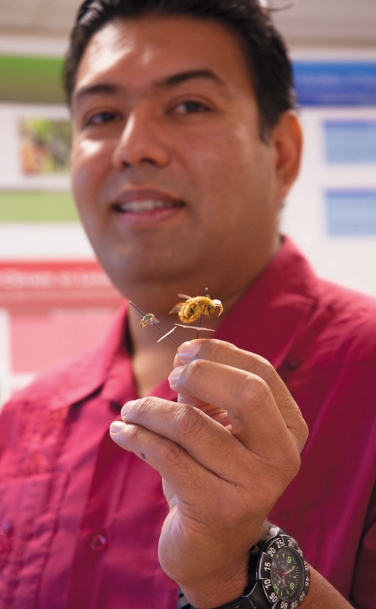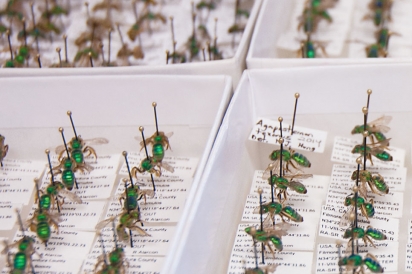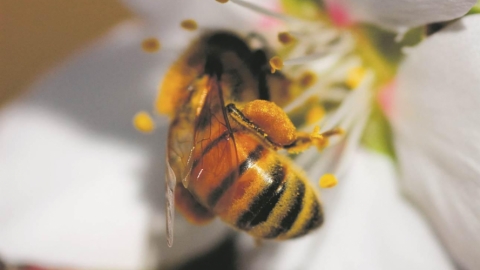Beyond the Honey Bee
Native bees are busy all around Ventura County
When you look into a garden or meadow and see a bee on a flower, you might assume it’s a honey bee. After all, the European honey bee, Apis mellifera, has become the predominate bee used for the pollination services that produce our food, according to Ruben Alarcón, PhD, associate professor of biology at California State University, Channel Islands. There are, however, an estimated 2,000 species of bees in the state.
I recently spoke with Alarcón, who spends his days studying pollinators, to learn more about our native bees. My first surprise was to learn an expert like Alarcón didn’t start his career studying them. On the contrary, Alarcón was more curious about flowers, the how and why they evolved into their wondrous variety of shapes, sizes, colors and scents.
“At some point I decided if I wanted to understand [the evolution] of flowers I’d have to understand the pollinators,” says Alarcón. Now he wants to learn more about the types of native bees that call Ventura County home to learn their role in pollination. We really don’t know much about them compared to other species, he says.
Much of the research, including Alarcón’s, had been on the honey bee, but his lab is now exploring several varieties of plant-pollinator systems. These include the native bees of California and the rolling coastal sage- and scrub-covered hills surrounding CSUCI’s Camarillo campus.
“I’m really interested in how the plants are co-evolving with the pollinators, how the bees are selecting the different shapes and colors of the flowers.” What he’s found is that the bees are interacting with a wider range of plants than expected, he says, adding that the research is ongoing.
Why this matters is that native bees need the highly specialized pollen found in native plants for nutrients to “feed their babies,” he says. Nonnative plants offer up nectar, which is like “an energy bar” for the native bees. In other words, it gives them a boost but isn’t a building block for their or their off springs’ health.
From 2013 to 2015, Alarcón conducted a study to monitor pepper fields throughout Ventura County to learn more about native bee pollinating activity. He wanted to see what types of bees visited the fields, and their pattern of pollination.
His students identified 64 varieties of native bees in those fields. The bees varied in appearance from the small iridescent emerald-green sweat bee (Agapostemon texanus) and large “furry” golden male carpenter bee (Xylocopa varipuncta) to the more familiar yellow-faced bumble bee (Bombus californicus). He hopes to continue the study in the coming years to track their benefits to agriculture.
POLLINATORS WITH PURPOSE
“Prior to the late ’90s and early 2000s,” says Alarcón, “much of our research on the relationships between flowers and their pollinators came from the ’40s to ’60s. For instance, scientists used to believe flowers’ traits could simply be used to predict their pollinators and if you went out to the field you were expecting to find a specific type of pollinator—such as a bee or hummingbird—on a certain flower.”
That’s just not the case, he says. “Pollinators are animals, and like animals they are opportunistic. Only 30 to 40% of plants have flower traits that can consistently be matched up with pollinators.”
Knowing what bee uses what food source is a big deal. Over 130 U.S. crops require insect pollination, and with the rising threat to honey bees from Colony Collapse Disorder, the hunt is on for answers and sustainability.
After studying the nesting and foraging behavior of native bees, Alarcón calls them “the sustainable pollinators” and has found some interesting benefits that native bees add to the pollination equation.
“Honey bees are very orderly,” he says, surrounded by his hundreds of specimens neatly mounted, labeled and categorized in trays in his lab. “They will be drawn to a certain crop or orchard and go on down the row from one plant to the next. Native bees are much more erratic and faster. ... They actually make honey bees more efficient. If a native bee bumps into a honey bee in a field, the honey bee will change its course and fly across a few rows and increase cross-pollination.”
This pattern helps growers, who might not even be aware it’s happening.
“Twenty-five to 30% of the pollination is actually coming from wild bees and flies,” Alarcón says. “Growers with fields closer to native landscapes—say, a hillside unsuitable for planting—are at an advantage by having more bees available.”
He believes native bees have a beneficial effect on crops, when native vegetation is allowed to surround fields of agriculture.
“There is growing evidence that wild, unmanaged bees can provide effective pollination services where sufficient habitat exists to support their populations,” adds Neal Williams, PhD, a pollination ecologist with the UC Davis Department of Entomology and Nematology, who conducted a study on bee pollinators.
His study of these wild native bees concluded there is uncertainty “in our knowledge of the quality of habitat for pollinators” and “more effort is needed to understand the vulnerability of pollination services. … Indeed it is crops where demand has most increased that we estimate greatest decline in wild pollinator supply.”
Wild bees face many of the same threats as honey bees, he says, including habitat loss, environmental pesticide exposure and climate.
When asked about the correlation between the cultivation of crops and decline in wild pollinators, Williams says that though his study doesn’t explicitly link changes in the wild bee population to different types of land use, he suspects that in the real landscapes, impacts are a combination of changes in the availability of resources as well as the presence of toxins.
In September, a federal appeals court struck down the Environmental Protection Agency’s approval of a pesticide called sulfoxaflor. I asked Williams how he thought this would affect the EPA’s approval of other widely used neonics like clothianidin and imidacloprid.
“It would be wise to include testing of toxicity of a variety of pesticides, herbicides and fungicide effects on a variety of bees,” says Williams, who agrees with Alarcón about the dearth of research on native bees. “There are data available to show differences in sensitivity among bee species,” Williams adds.
“We are very interested to see testing of impacts on different species and also additional field-based study of impacts of pesticides on wild bee populations,” he says. “It is hard to say what the impact will be on EPA testing/regulation, etc. because there are a variety of factors, not all related to pollinators, that are involved in such decisions.”
Visit EdibleVenturaCounty.com to read about the project Alarcón is working on with Camarillo beekeeper Wayne Scott to identify why he’s experiencing much lower bee mortality rates with his hives than the average beekeeper.
BEE SUPPORTIVE
CSUCI Professor Ruben Alarcón shares some things we can do to encourage and support the local native bee population.
Provide native plants. Though you may see native bees getting nectar from your nonnative plants, it’s often not as nutritious as what native species provide, forcing the bees to work harder and travel farther. Common native plants found locally that support bees include California lilac (Ceanothus ‘Concha’), McMinn manzanita (Arctostaphylos ‘McMinn’), Silver bush lupine (Lupinus albifrons) and Redbud (Cercis orbiculata). Sages are also good plants for native bees. Different bees are active at different times, so vary the flowering times of your plantings.
Keep bare earth. A large percentage of bees are “earth nesters,” meaning they burrow into the soil to build their nests and raise their young, says Alarcón. Some bees cannot burrow through mulch or gravel, so leave them a little margin of ground under your fence or along an unused side yard.
Provide housing. Ground-breeding native bees use fallen limbs, so leave them in place if you have them in your yard or create a “bee house” by drilling holes in a salvaged, untreated tree trunk. Think of it as an interesting natural art piece, says Alarcón says. “You can tell when the bees have found it, as the holes will be sealed with small bits of chewed up leaves, pebbles or tree sap that the bees find.”
Provide water or damp soil. Native bees collect mud for their nests and have evolved to need less water. So leave damp soil or a shallow saucer or two to catch water while irrigating. Make sure it is shallow enough to dry up during the day—you don’t want mosquitoes.
Avoid chemicals. Chemicals are toxic to bees. If you must use a chemical, make sure it’s not systemic and that bees are not present while you’re applying it. Systemics stay in the plant’s roots, stems, flowers and fruits produced. Chronic exposure to pesticides during the early life stage of bees may contribute to inadequate nutrition and/or direct poisoning, which may impact the survival and development of bee brood, according to a scientific study published by PLOS.org.
For more info and publications about supporting and protecting bees’ habitats, visit Xerces Society for Invertebrate Conservation at Xerces.org.








